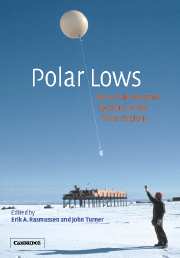6 - Forecasting of polar lows
Published online by Cambridge University Press: 07 December 2009
Summary
Aspects common to both polar regions
Introduction
Polar lows can have a severe impact on maritime operations and can cause considerable disruption when the more severe systems make landfall. In areas such as the North Sea, there are many gas and oil platforms and it is necessary to have good forecasts of the arrival of severe mesoscale lows to minimize the impact on operations. Within the Antarctic, most of the mesoscale lows are not as vigorous as their counterparts in the north. Nevertheless, they can still cause severe problems during the summer relief operations at the research stations and affect work in the deep field.
Polar low forecasting is an integral part of the general forecasting problem and the results are dependent on the success of the overall forecast. Polar lows often result in a rapid deterioration of the weather at a specific location, and accurate time indications in the forecasts are important. In this chapter we will examine the means by which forecasters attempt to predict the formation and development of mesocyclones and polar lows. The output from numerical weather prediction (NWP) analysis and forecast systems can be used to try and infer where and when mesocyclone developments may take place in a particular region. Satellite imagery and other satellite data are indispensable in identifying and predicting the movement of existing mesoscale vortices a few hours ahead.
- Type
- Chapter
- Information
- Polar LowsMesoscale Weather Systems in the Polar Regions, pp. 501 - 574Publisher: Cambridge University PressPrint publication year: 2003
- 2
- Cited by



